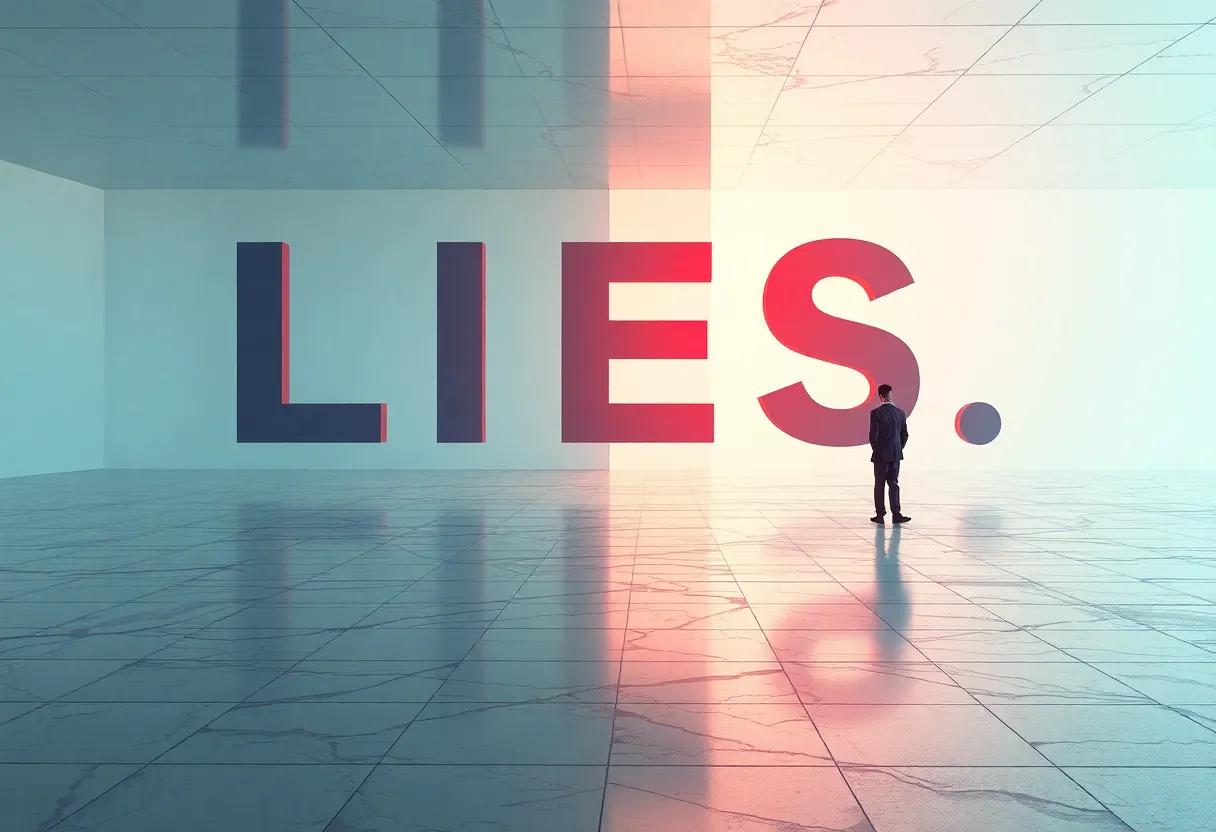In the labyrinthine world of Philip K. Dick’s creativity, reality frequently enough wears a mask-shifting, fragile, and endlessly deceptive. Lies, Inc.,one of Dick’s less mainstream yet profoundly intricate explorations,invites readers into a shadowy realm where truth is as malleable as memory itself. This review seeks to navigate the tangled threads of Dick’s narrative, unraveling the novel’s themes and stylistic nuances with measured reflection. By peering beneath the surface of Lies, inc., we aim to uncover what lies at the heart of its unsettling vision and understand its place within the broader landscape of speculative fiction.
The Intricate World of Lies Incorporated Explored Through a Multifaceted Narrative Lens

At the heart of Lies, Inc. lies a deftly woven tapestry of deceit, where the boundaries between reality and illusion blur with each twist of the narrative. Philip K. Dick immerses readers into a corporate world where truth is a commodity, manipulated and sold by the enigmatic agency at the center of the story. Through a multifaceted lens, the novel explores not just the mechanics of deception, but the psychological toll it takes on those entangled in its web.Characters are crafted with striking complexity, their motives and perceptions shifting in a kaleidoscopic fashion that invites readers to question what is authentic and what is a carefully constructed façade.
The narrative structure itself acts as a reflection of the themes it probes-layered, fragmented, and intentionally disorienting. This approach pushes the reader to engage actively with the story, piecing together clues from unreliable narrators and conflicting viewpoints. In doing so, Dick invites us to consider several pivotal questions:
- How malleable is memory in constructing personal truth?
- To what extent is control over information a form of power?
- Can one ever fully detach from the lies that shape identity?
These inquiries underscore the novel’s enduring relevance in a world increasingly dominated by narratives shaped as much by fiction as by fact.
The Blurring Lines Between Reality and Illusion Examined in Philip K dicks Dystopian vision
Philip K.Dick masterfully challenges our perceptions of reality, intertwining layers of truth and fabrication in a narrative that arrests the mind. Through his dystopian lens, the distinction between what is authentic and what is merely an illusion becomes a fluid spectrum rather than a fixed boundary. Characters navigate a world where identity is constantly questioned, and memories are as unreliable as the shifting landscape around them. This fluidity invites readers to reflect on contemporary fears about manipulation-whether through technology, media, or political power structures-making the work chillingly relevant to modern sensibilities.
In Lies, Inc., the mechanisms of deception are not solely external forces but internal conflicts, illustrating how self-perception can be compromised by imposed narratives. The narrative flow simulates this distortion elegantly, placing the audience in the protagonist’s disoriented mindset. Key elements contributing to this effect include:
- Memory alteration: The blurring of past and present challenges the notion of a stable self.
- Reality hacking: Entities capable of manipulating truth serve as metaphors for societal control.
- Psychological fragmentation: Characters exhibit fractured identities that reflect larger systemic deceptions.
| Element | Effect | Symbolism |
|---|---|---|
| Memory Implantation | Creates confusion | Manipulation of perception |
| simulated environments | Distorts reality | Questioning authenticity |
| Double Agents | Instills distrust | Ambiguity of identity |
themes of Control Authority and Personal Freedom Interwoven with Thought Provoking Depth
Philip K. Dick masterfully crafts a world where the fragile balance between control, authority, and personal freedom is constantly tested.Throughout Lies, Inc., characters navigate an opaque system that manipulates not only reality but the very perception of truth itself.this intricate layering unveils how external power structures impose their will, frequently enough at the expense of individuality and autonomy. With every twist, readers confront the unsettling question: to what extent do invisible forces shape our choices, and where lies the boundary between protection and oppression?
Embedded within the narrative are subtle yet powerful examinations of:
- The paradox of autonomy-when freedom is offered conditionally under surveillance.
- The erosion of trust-between individuals and the governing apparatuses meant to safeguard them.
- The malleability of memory and its role in defining identity and control.
Such themes invite readers to rethink the dynamics of power beyond the page, transforming the novel into a prism through which societal constructs are critically examined.
| Theme | Illustration in Lies,Inc. | reflective Questions |
|---|---|---|
| Surveillance | Constant monitoring of thoughts and actions | Does watching prevent chaos or create control? |
| Identity | Manipulation of memories and realities | What defines the true self if perceptions are altered? |
| Authority | Power wielded through hidden institutions | When does authority become authoritarianism? |
Character Development and the psychology of Deception Illuminated with Nuanced Perspectives
Philip K. Dick’s characters breathe complexity, embodying the fragile interplay between truth and illusion. Protagonists frequently enough grapple with fractured identities,their internal conflicts meticulously crafted to mirror the thematic core of deception. Through a nuanced examination of their motives, fears, and shifting loyalties, Dick exposes how psychological manipulation serves as both a survival strategy and a self-imposed prison. These figures are not mere pawns in a conspiracy; they are deeply human, navigating moral ambiguity and existential crises that challenge readers to question the reliability of perception itself.
- Layered Personalities: Characters reveal multiple facets, masking true intentions beneath carefully curated façades.
- Emotional Ambiguity: Their relationships oscillate between trust and betrayal, reflecting the unstable foundations of identity.
- Cognitive Dissonance: Minds struggle to reconcile conflicting realities, illustrating psychological detriments of deception.
Exploring the psychology behind these complex portrayals, one finds that deception is not an external force alone – it is indeed internalized and self-sustaining. The characters’ continuous negotiation between authenticity and disguise ultimately acts as a mirror to the reader’s own perceptual biases. This psychological labyrinth is vividly mapped out in the table below, highlighting key character traits alongside their deceptive behaviors and underlying motivations:
| Trait | Deceptive Behavior | Motivation |
|---|---|---|
| Fragmented Identity | Uses false personas to obscure true self | Fear of vulnerability |
| Paranoia | Distrusts allies, misleads for self-preservation | Survival instinct |
| Moral Ambiguity | Engages in manipulation without guilt | Pragmatic self-interest |
| Emotional Detachment | Suppresses feelings to maintain control | Prevent emotional exploitation |
The Role of Technology in Shaping Perception and Manipulating Truth in the Story’s Universe
In the fabric of Lies, Inc., technology emerges not merely as a tool but as a formidable architect of reality itself. The story masterfully explores how advanced systems and devices blur the boundaries between what is authentic and what is fabricated. Within this universe, perception becomes a malleable construct, with characters constantly questioning the veracity of their experiences and memories.Technology, thus, functions as the invisible puppeteer, orchestrating layers of deception so intricate that truth becomes a scarce commodity. This manipulation extends beyond simple misinformation, embedding falsehoods deep into the subconscious, creating doubts that ripple through personal identity and societal trust.
Key elements of technological influence depicted include:
- Memory modification and implantation
- Simulated realities indistinguishable from the genuine
- Surveillance systems that selectively reveal or conceal information
- Artificial intelligence curating perspectives and narratives
This complex interplay reveals a chilling commentary on power and control, where technology empowers unseen forces to dictate not only actions but beliefs and loyalties. To visualize this dynamic, the following table outlines how different technological mechanisms in the story effect human cognition and social order:
| Technological Mechanism | Effect on Perception | Impact on Society |
|---|---|---|
| Memory Implantation | Alters personal reality | Erodes individual identity |
| Simulated Environments | Creates indistinguishable illusions | Breaks down consensus reality |
| Selective Surveillance | Controls information access | Shapes social power dynamics |
| AI Narratives | Curates belief systems | Influences collective memory |
Innovative Plot Twists and Their Impact on Reader Engagement and Thematic Unfolding
Philip K.Dick’s mastery in Lies, Inc. lies not only in the story’s core premise but in the artful deployment of plot twists that serve as cognitive jolts for the reader.each unexpected revelation challenges assumptions and injects a dynamic pulse into the narrative,compelling readers to constantly reassess the nature of reality within the story.The plot twists operate on multiple levels: they disrupt the linear progression of the tale and simultaneously deepen thematic exploration,shining a spotlight on the mutable boundaries between truth and deception,identity and illusion.
The impact on reader engagement is multifaceted:
- Heightened Suspense: Twists prolong curiosity and maintain an unpredictable narrative flow.
- Psychological Involvement: Readers are encouraged to question the reliability of characters and narrators alike.
- Thematic resonance: Surprises are not superficial but intricately tied to the novel’s critique of control,freedom,and perception.
| Plot Twist | Thematic Echo | Reader Effect |
|---|---|---|
| Shifting Realities | Nature of Truth | Disorientation and curiosity |
| Hidden Agendas | Control and Autonomy | Skepticism and suspicion |
| False Memories | identity and Self | Emotional engagement |
By weaving these unexpected turns seamlessly into the fabric of the story, Dick does more than surprise his readers; he fosters an immersive experience that transforms narrative twists into catalysts for profound reflection. This technique invites readers not just to witness confusion and revelation but to feel it, making Lies, Inc. an enduring meditation on the fragility of perception in a world dominated by deception.
Stylistic Choices and Literary Techniques Enhancing the Atmosphere and Intellectual Challenge
Philip K. Dick masterfully utilizes a blend of surreal imagery and fragmented narrative structures to immerse readers in a world where reality is constantly in flux. His strategic deployment of unreliable narrators and abrupt tonal shifts amplifies the sense of disorientation, compelling readers to question the very fabric of truth within the story. These stylistic decisions are not merely ornamental but serve as conduits to provoke deeper intellectual engagement, urging audiences to decode hidden meanings beneath layers of paranoia and duplicity. The interplay between vivid metaphors and stark, minimalist prose generates a compelling tension that keeps readers both captivated and unsettled.
Moreover, Dick’s adept use of literary techniques such as foreshadowing and symbolic motifs creates a rich tapestry of thematic complexity. The recurring motif of mirrors and reflections eloquently underscores the novel’s exploration of identity and deception. Below is a concise overview of key techniques and their effects on the narrative atmosphere:
| Technique | Purpose | Effect on Atmosphere |
|---|---|---|
| Unreliable Narrator | Challenge perception | Creates suspense and doubt |
| Fragmented Narrative | Reflect mental instability | Disorienting, immersive |
| Symbolism | Reveal hidden themes | Layered, thought-provoking |
| Foreshadowing | build anticipation | Heightens tension |
- Contrast between light and shadow to symbolize truth and deception
- Elliptical dialog that enhances ambiguity
- Psychological realism that grounds the sci-fi elements
Comparative Analysis with Other Works in the Speculative Fiction Genre Highlighting Unique Elements
Philip K. Dick’s Lies, Inc. stands apart in the speculative fiction realm by weaving reality and illusion into a seamless narrative, a feat that many contemporaries in the genre approach with more overt sci-fi tropes. Unlike works that heavily rely on elaborate world-building or futuristic technology, Dick zeroes in on the psychological labyrinth of deception and identity. while novels like Neuromancer or Snow Crash dive headlong into cyberpunk aesthetics and digital landscapes,lies,Inc. remains grounded in the volatile human psyche, spotlighting the malleability of truth in a world where reality itself is a commodity. This focus creates a unique tension - readers are not just spectators of a dystopian future but are invited to question the authenticity of their own perceptions.
- Psychological depth: Unlike high-tech spectacle, Dick emphasizes internal conflicts and fragmented consciousness.
- Subtle dystopia: The societal decay is implied through personal deception rather than explicit authoritarian regimes or wars.
- Blurring of reality: The narrative challenges the very concept of what is real, a hallmark subtly different from other speculative works.
| Aspect | Lies, Inc. | Typical Speculative Fiction |
|---|---|---|
| Focus | Internal psychological struggle | External world-building and technology |
| World setting | Subdued futuristic dystopia | Expansive and visually rich futurescapes |
| Conflict | Deception of self and others | Usually involves conflicts like war or rebellion |
| Approach to Reality | Fluid, questioning what’s real | Often more definitive or scientifically explained |
This distinctive approach makes Lies, Inc. resonate on a meta-fictional level, where the very act of reading becomes a journey into uncertainty. While other speculative fiction titles might present technologies and alien worlds as clear-cut escapes or threats, Dick’s work fixes the gaze inward – at the unstable ground beneath societal facades. The novel’s subtlety in addressing paranoia and misinformation is eerily prescient,highlighting unique elements that continue to influence modern speculative narratives focusing on cognitive dissonance and the unreliable nature of history and memory.
Philosophical Questions Raised About Identity Morality and the Nature of Reality in Lies Incorporated
Lies, Inc. plunges readers into a labyrinth where identity becomes as malleable as the shifting narratives within the story. philip K. Dick masterfully blurs the lines between authentic existence and manufactured realities, prompting us to question the very essence of selfhood.How much of our identity is truly ours versus a construct imposed by external forces? The novel’s characters grapple with fragmented selves, leaving readers to ponder whether identity is an inherent truth or simply a perpetuation of societal deception. This exploration defies simple answers, instead inviting a deep meditation on the fluidity of who we are-and whether “we” can ever be truly known, even to ourselves.
Morality, too, is unsettled under the novel’s scrutiny. In a world where reality is manipulated and truths are commodities, traditional ethical frameworks falter. What becomes of right and wrong when lies serve a strategic purpose? Dick’s narrative challenges readers to reconsider moral absolutes amid pervasive duplicity. The interplay between manufactured realities and genuine human experiences raises pressing questions:
- Is morality context-dependent within constructed worlds?
- Can deception be justified if it preserves a greater good?
- how do we define truth when layers of reality are indistinguishable?
| concept | Philosophical Implication |
|---|---|
| identity | The self as a fragmented, fluid construct |
| Morality | Ethics challenged by contextual deception |
| Reality | Objective truth vs. subjective experience |
How Unraveling Deception Reflects Contemporary Societal concerns in a Timeless Science Fiction setting
In the labyrinthine universe of Lies, Inc., deception is more than a mere plot device-it serves as a mirror reflecting deep-seated anxieties prevalent in today’s world. Through a richly layered narrative, Philip K. Dick explores the erosion of trust in institutions, the manipulation of information, and the fragility of personal identity when confronted with pervasive falsehoods. These themes resonate powerfully in an era marked by “fake news,” surveillance capitalism, and digital echo chambers, illustrating how science fiction’s speculative fabric remains profoundly relevant.The novel’s timeless setting, though firmly rooted in a futuristic dystopia, invites readers to question the nature of reality itself and confront uncomfortable truths about societal complacency amidst rampant dishonesty.
What elevates this narrative is its nuanced examination of the mechanisms behind deception-both systemic and intimate. Characters navigate a world where alliances are uncertain, and truth is a commodity fiercely contested. Some key reflections include:
- Information Control: The state’s role in shaping public perception parallels contemporary concerns about media manipulation.
- Identity Fluidity: The blurring of personal and fabricated personas highlights modern anxieties surrounding online self-presentation.
- Resistance and Compliance: Characters embody varying responses to deception, from reluctant acceptance to rebellious defiance.
| Theme | Contemporary Parallel | Impact on protagonist |
|---|---|---|
| Information Control | Media manipulation & propaganda | Sows mistrust, fuels paranoia |
| Identity Fluidity | Social media alter egos | Creates confusion, identity crisis |
| Resistance and Compliance | Activism vs. apathy | Shapes character arcs & tensions |
Recommendations for Readers Interested in Complex Narratives Psychological Thrillers and Speculative Fiction
For those captivated by intricate plots that bend reality and challenge perception, Lies, Inc. offers a masterclass in narrative complexity. Philip K. dick crafts a labyrinthine world where trust is a fragile currency, and every character harbors secrets beneath layers of deception. Readers who gravitate toward psychological thrillers will appreciate the seamless blend of tension and introspection, as the protagonist grapples with shifting identities and elusive truths. This novel isn’t just about twists; it’s a deep exploration of the human psyche under surveillance, paranoia, and manipulation.
Speculative fiction enthusiasts will find the speculative technology and dystopian atmosphere of Lies, inc. especially compelling, as Dick pushes the boundaries of what reality means in a future shaped by corporate control and altered memories. The story invites readers to question not only the fabric of the narrative but also the very nature of existence and control. Below is a swift reference to help readers decide if this novel fits their tastes:
| Element | Reader Appeal |
|---|---|
| Complex Narratives | High |
| Psychological Depth | Very High |
| Speculative World-Building | strong |
| Fast-Paced thriller Elements | Moderate |
- Curious about identity and memory: This novel’s core captivation.
- Enjoy mind-bending dystopias: You’ll love the sprawling corporate-controlled future.
- appreciate subtle character development: Dick’s characters reveal complexity and vulnerability.
The Enduring Legacy of Lies Incorporated Within Philip K Dick’s Oeuvre and Its Influence on Popular Culture
Philip K. Dick’s Lies, Inc. stands as a quintessential exploration of manipulated realities and the fragility of trust, themes that persistently echo throughout his expansive body of work. The novel’s intricate portrayal of a society where truth is malleable and deception is institutionalized offers a profound commentary on power structures that shape human perception. Its resonance extends beyond literature, influencing a myriad of visual and narrative forms within popular culture. From sci-fi cinema to television series and graphic novels, Dick’s prescient vision molds creative landscapes that challenge audiences to question the authenticity of their experiences.
At the core of Lies, Inc. lies an unsettling reflection on the duality of identity and the pervasive nature of subterfuge. This has sparked various reinterpretations and adaptations, often manifesting through:
- Complex narrative architectures that mimic the fluidity of truth
- Character archetypes grappling with fragmented selves in dystopian settings
- Visual motifs emphasizing illusion and reality intertwined
These elements have become staples within the genre, influencing creators to adopt a more nuanced treatment of deceit and consciousness. Presented below is a concise overview of thematic parallels between Lies, Inc. and notable works inspired by it:
| Work | Medium | Key Element |
|---|---|---|
| Blade Runner | Film | Artificial memories and identity crisis |
| Black Mirror | TV Series | Technological distortions of reality |
| the Matrix | Film | Simulated worlds questioning existence |
Insights into Philip K Dicks Writing Style Creative vision and Thematic Preoccupations in Lies Incorporated
Philip K. Dick’s prose in Lies, Inc. is a kaleidoscope of fragmented realities and suspenseful ambiguity, inviting readers to question the very nature of truth. His writing fuses sharp,rapid-fire dialogue with dense psychological introspection,moving seamlessly between paranoia and moments of stark vulnerability. The narrative’s structure mirrors the protagonist’s fractured perception,employing shifts in perspective and timelines that blur the line between certainty and illusion. This stylistic approach not only constructs an immersive dystopian world but also evokes an unsettling atmosphere where every character and event is steeped in mistrust. At its core, Dick’s creative vision crafts a labyrinth of deception - one where ‘reality’ is a malleable concept shaped by forces beyond control.
The themes explored in Lies, Inc. resonate with classic Dickian motifs that revolve around identity, surveillance, and the manipulation of memory. Central to the narrative are:
- The Fragility of Identity: Characters often wrestle with fragmented or false selves, raising existential questions about who they truly are.
- Institutional Control: The omnipresence of the titular company underscores the pervasive influence of corporate and governmental powers in shaping societal narratives.
- The Nature of Truth: Truth becomes a battleground, with facts twisted and realities manufactured, leaving readers to navigate a maze of deception alongside the protagonist.
| Element | Impact on Reader |
|---|---|
| Paranoia | Creates a persistent sense of unease and distrust. |
| Distorted Reality | Blurs boundaries between fact and fiction. |
| Technological Intrusion | Highlights themes of control and surveillance. |
Lies, Inc. stands as a compelling testament to Philip K. Dick’s ability to weave intricate narratives that challenge our perception of truth and reality. This exploration into deception is not just a story but a mirror reflecting the complexities of trust in a world where reality is never quite what it truly seems. Whether you approach it as a sci-fi enthusiast or a curious thinker, Lies, Inc. invites readers to question the very fabric of their beliefs-making it a timeless piece worthy of reflection long after the final page is turned.




